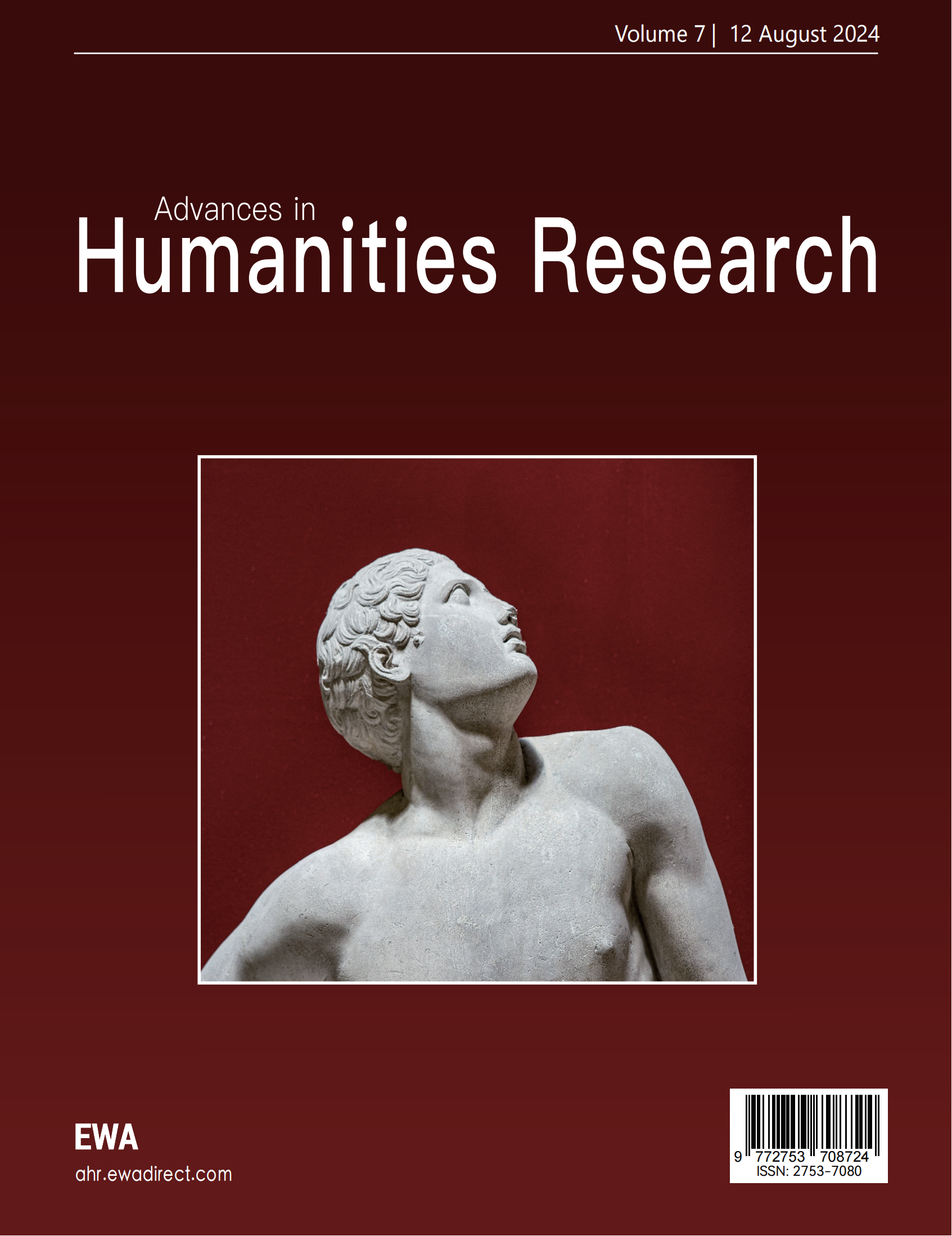1. Introduction
Nepal is located in an important geopolitical area for China. However, as a small country with inconvenient transportation and relatively underdeveloped economy, Nepal has received relatively low academic attention. With the implementation of the "Belt and Road" initiative and considering Nepal's significant strategic importance among the countries along this route, there is a need to further deepen and expand research on Nepal’s politics, economy, trade, and culture. Scientific research requires a thorough review and summary of previous studies and results to clarify development pathways and raise research questions. This paper, based on Nepal’s important position in South Asian studies, summarizes and reviews research issues and achievements over the past decade related to Nepal in areas such as ethnic culture, foreign policy, Chinese language teaching, foreign trade, and tourism, and looks forward to future research.
2. Overview of the Basic Situation of Research on Nepal
The author conducted a fuzzy search with the keyword "Nepal" on CNKI, and as of May 2024, there were 7,335 results in Chinese. The following is a brief overview of the literature from the aspects of research content distribution, researchers, and research institutions.
2.1. Overview of Research Content Distribution
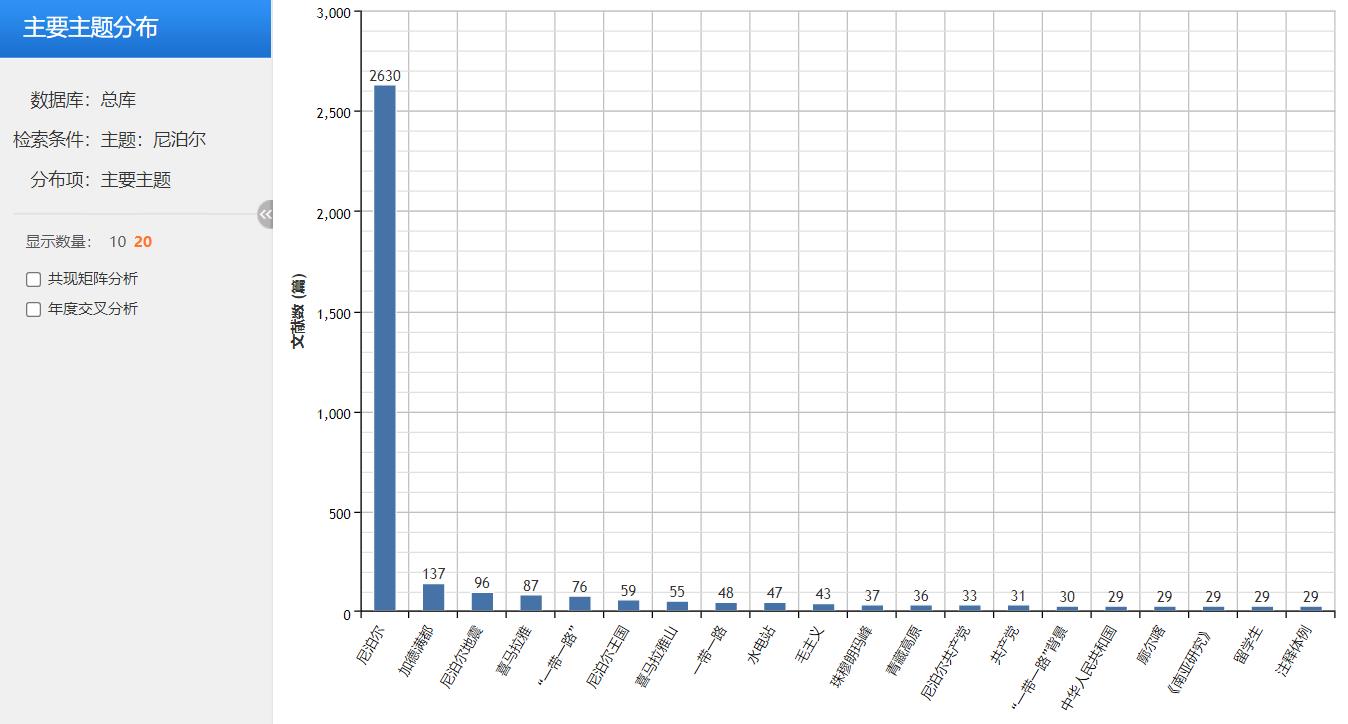
Figure 1. Distribution of Research Themes
From the distribution of research themes, experts and scholars focus on Nepal's religious culture, foreign policy, economic construction, and tourism. Kathmandu is the main entry point for research. Nepal is a multi-ethnic and multi-religious country, and its cultural diversity is a topic of interest for researchers. The existing literature on religious culture is relatively serious, not numerous but of high academic value. A few documents explore tourism economy (mainly focusing on the development of Nepal's tourism resources), while a considerable portion belongs to travel notes, mostly impressions of short trips to Nepal, which have limited academic value but demonstrate Nepal’s cultural appeal to tourists from various countries. Media coverage of disasters and crises is a long-term topic in journalism and media studies, significantly affecting the understanding and perception of global disasters and crises. Therefore, there is a higher volume of research literature related to the 2015 Nepal earthquake. Scholars from different fields have studied and analyzed the earthquake from aspects such as assessment, emergency response, and post-disaster reconstruction. In recent years, under the backdrop of the "Belt and Road" initiative, researchers have been paying more attention to issues such as Sino-Nepalese diplomacy and economic construction cooperation. Graduate students tend to focus on the situation of Nepalese students in China, the current state and possible paths of Chinese language teaching in Nepal.
2.2. Basic Situation of Researchers
2.2.1. Overview of Main Researchers
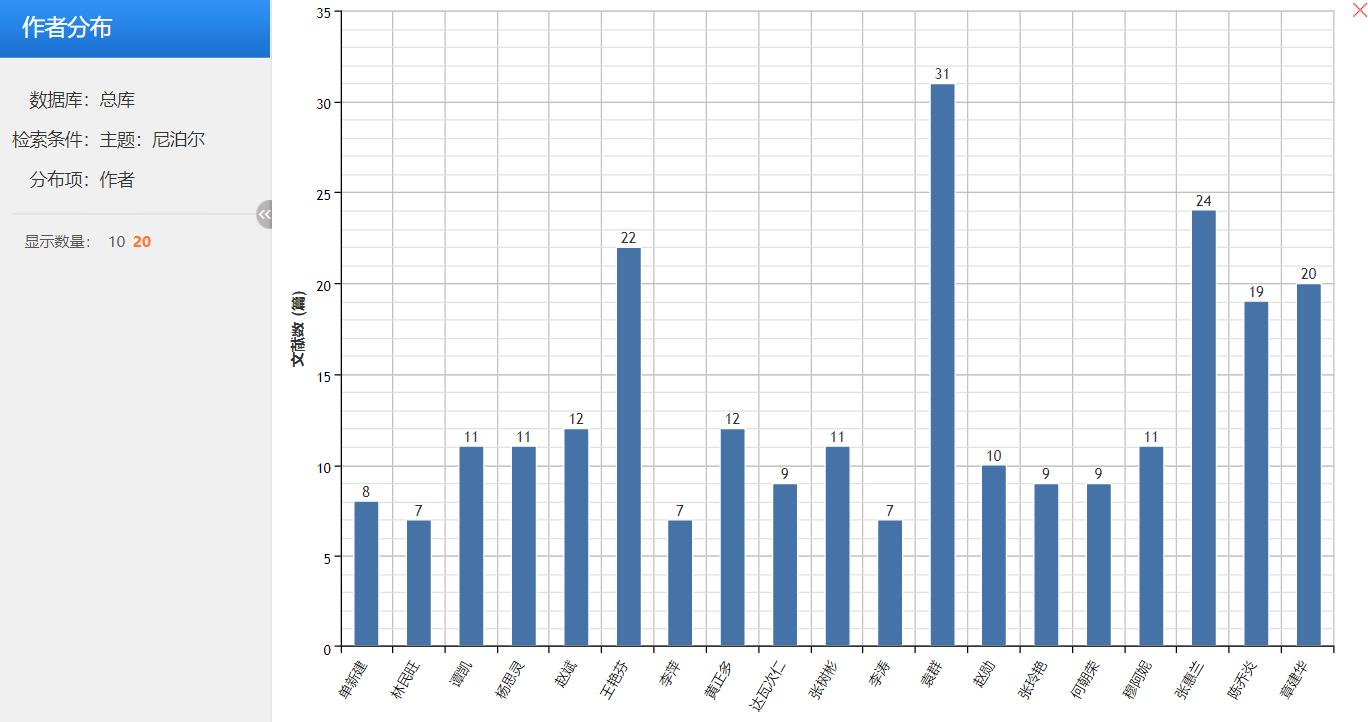
Figure 2. Distribution of the Authors
Within the scope of South Asian studies, the team of researchers focusing on Nepal is not large. Among these researchers, Yuan Qun mainly studies Nepalese party policies, Zhang Shubin and Li Tao focus on Nepal’s political situation, He Chaorong’s research is mostly on Nepalese political parties, Huang Zhengduo emphasizes the geopolitical aspects of Sino-Nepalese relations and Nepal’s economic development, Wang Yanfeng focuses on Nepal's foreign policy, Mu Aini concentrates on Sino-Nepalese border issues, Zhang Huilan’s research covers Nepalese religious culture, social livelihood, and government administration, Tan Kai, Shan Jianxin, and Zhang Guohong mainly study the Nepal earthquake from the perspective of geographical sciences, and Zhao Xun and Zhang Lingyan focus on the study of Chinese language learning among Nepalese students and volunteer Chinese teachers. Notably, internationally renowned scholar Wang Hongwei has not published many journal articles, but his research outcomes are significant. His book "The Kingdom of Snowy Mountains: Nepal" provides a comprehensive introduction to Nepal’s natural conditions, history, political institutions, administrative divisions, and national economy. His edited "Country Profiles: Nepal" offers an all-encompassing interpretation of Nepal from history, culture, geography, politics, and economy, serving as a panoramic "window" for Chinese people to understand Nepal.
2.2.2. Research Institutions and Literature Publication Situation
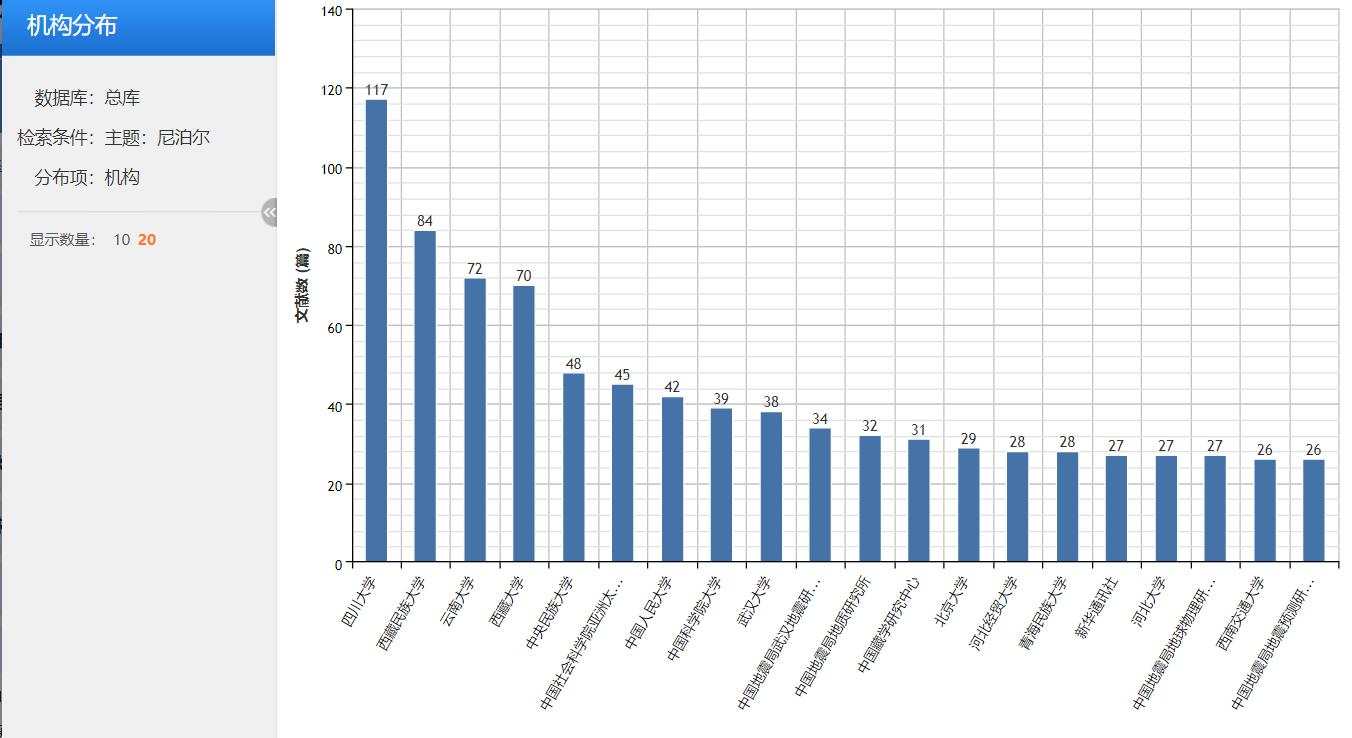
Figure 3. Distribution of Institutes
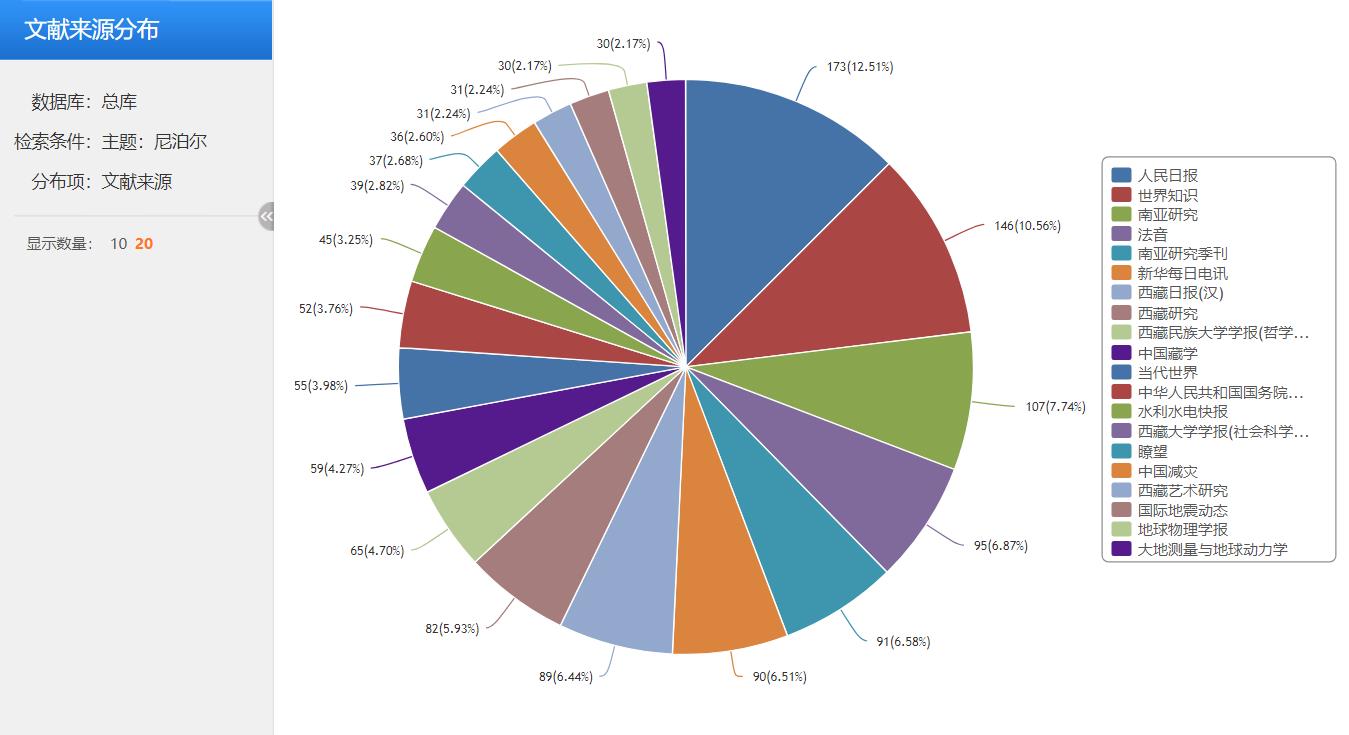
Figure 4. Distribution of Literature Sources
The primary academic institutions in China specializing in Nepal studies include the Nepal Research Center at Hebei University of Economics and Business (established in 2014), the Nepal Research Center at Beijing Foreign Studies University (established in 2017), the Nepal Research Center at Yunnan University, the Nepal Research Center at Sichuan University, the Nepal Research Center at Yunnan Minzu University, the Nepal Research Center at China Three Gorges University, the Nepal Research Center at Tibet University, and the Nepal Research Center at the Silk Road Institute of Northwest University. Due to the regional characteristics of Nepal studies, researchers are mainly experts and scholars from various research institutes or research centers, as well as those specializing in country and regional studies at various universities. The research literature collected by CNKI primarily focuses on publications such as "South Asian Studies," "South Asian Studies Quarterly," "Tibet Studies," "Journal of Geo-science," and various university journals.
3. Review and Commentary on Major Research Findings
3.1. Research on the General Overview of Nepal
The existing literature on Nepal's general overview primarily focuses on religion, ethnicity, royalty, and traditional culture. Zhang Huilan believes that traditional Nepali culture is characterized by religiosity, regionalism, ethnicity, and inclusiveness [1]. Religion is the most prominent feature of Nepali culture. Zhang Huilan points out that the flourishing of Nepali religious culture benefits from religious policies that maintain freedom of religious belief, neither excluding nor attacking any religion. The state protects and supports religious activities, and safeguards religious heritage and temples [2]. Wang Hongwei asserts that "the main ethnic group in the current Kingdom of Nepal is the Nepali"[3]. Hu Shisheng argues that Nepal has no dominant ethnic group and roughly divides Nepali ethnic groups into two major categories based on linguistic families: the Tibeto-Burman and the Indo-Aryan [4].
3.2. Research on Nepal's Foreign Policy
In the research on Nepal's foreign policy, Huang Zhengduo points out that Nepal is an indispensable part of promoting the "Belt and Road" cooperation in South Asia [7]. Yin Hui, Zhao Jiahong, and Wang Zihao analyze the current status and challenges of China-Nepal cooperation in the post-pandemic era and propose countermeasures [8]. Luo Haoyuan explores Nepal's foreign policy from the perspective of small country vulnerability and its policy cognition and strategic choices regarding the "Belt and Road," aiming to enhance communication between the media, enterprises, and people of China and Nepal, and to strengthen Nepal's infrastructure [9].
3.3. Research on the Impact of the "Belt and Road" Initiative on Nepal
In the context of the "Belt and Road" initiative, research on China-Nepal economic cooperation and assistance has also increased. Zhang Haibing and Zhou Taidong's book "Nepal and the 'Belt and Road'" presents detailed progress in China-Nepal cooperation, analyzing China's aid, trade, and investment in Nepal, and evaluating the opportunities and challenges faced by China-Nepal cooperation under the "Belt and Road" initiative. It also comprehensively analyzes cooperation between India and Nepal and trilateral cooperation among China, Nepal, and India, highlighting Nepal's different foreign policies towards China and India [10]. Liu Yichun and Ren Juan believe that current domestic research on Nepal and the "Belt and Road" focuses on Nepal's surrounding relationships and regional studies, serving China's diplomacy and development. The stability and development of the western border region are crucial for China-Nepal relations. The research emphasizes constructing a new type of major power diplomacy with the concept of a "community of shared future for mankind," discussing political, security, economic, cultural, ecological, and religious aspects [11]. Wang Yanfeng points out that Nepal is a country in South Asia that receives a high amount of foreign aid per capita. With the continuous growth and persistence of aid, many negative impacts have gradually emerged, such as the continuous expansion of government size, increasing debt burden, solidification of people's dependency mentality and habits, and even phenomena harming local economic development and national sovereignty [12]. Yan Liping and He Jingyu point out that Nepal is one of the countries that has received China's educational aid for the longest period. China's educational aid to Nepal has gone through three stages: politically-led, diversified development, and win-win cooperation. Under the "Belt and Road" initiative, the basic experience of China's educational aid to Nepal is to implement the Study in China Plan, focus on cultivating local teachers, create an international education exchange platform, and deepen cultural exchanges [13].
In terms of trade and economy, due to the small scale of China-Nepal trade and the single nature of commodities, it has attracted little attention from scholars. Existing literature suggests that research on China-Nepal trade by domestic and foreign scholars can be roughly divided into two categories: studies on the current status, existing problems, and policy recommendations for China-Nepal bilateral trade, and studies on the development of border trade between the western border region and Nepal. Song Zhihui analyzes the factors restricting the deep development of bilateral economic and trade cooperation, such as transportation and trade protection, by combining theory and reality from the perspectives of Nepal's trade management system and investment management system, believing that the economies of China and Nepal are highly complementary and that there is significant potential for the development of bilateral economic and trade cooperation [14]. Gao Liang (Kalyan Raj Sharma) uses quantitative analysis methods based on recent data on the scale, growth rate, and trade structure of China-Nepal trade, concluding that there is a strong correlation between China-Nepal trade and the GDP of the western border region. The article concludes by proposing effective paths for developing China-Nepal trade from the perspectives of information sharing, infrastructure construction, and policy support [15]. Huang Zhengduo and Li Yan analyze Nepal's economic conditions to enumerate the factors restricting China-Nepal economic and trade cooperation and propose targeted countermeasures: The Chinese government and enterprises can cooperate and invest with Nepal in hydropower resource development; Nepal, as a Buddhist tourist destination, can strengthen tourism cooperation with China; enterprises should fully play their role and continuously explore new forms of economic and trade cooperation; establish an information exchange platform and leverage the intermediary role of non-governmental organizations [16].
Many scholars believe that the western region is a key point in the relationship between China and Nepal and Nepal's participation in the "Belt and Road" initiative. Among them, Di Fangyao and Liu Xingjun believe that Nepal is currently the largest foreign trade partner of the western border region. The communication mechanism between the two sides is smooth, with complete transportation and trade facilities. Whether from the perspective of trade history or realistic trends, Nepal is an important gateway for China to South Asia [17]. Based on the perspective of cross-border RMB business, Dawasa Zhen et al. analyzed the current situation and existing problems of the development of border trade and financial cooperation between China's western border region and Nepal under the background of the "Belt and Road" initiative. They proposed countermeasures to promote China-Nepal financial cooperation and increase the use of RMB across borders [18]. The consensus reached by numerous studies is that developing China-Nepal trade is crucial for promoting the development of both countries, whether from a political or economic perspective, and aligns with the direction of strategic cooperation between the two countries. There is significant complementarity and correlation between China-Nepal trade, with substantial potential for development.
In summary, from the Chinese perspective, scholars believe that Nepal's participation in the "Belt and Road" initiative holds significant strategic importance for China. It plays a crucial role in the stability of China's border regions, the development of the western areas, and the cooperation with South Asian countries.
3.4. Research on Teaching Chinese in Nepal
Historically, the exchanges between China and Nepal have a long-standing tradition. Since the introduction of the "Belt and Road" initiative in 2013, China's influence on Nepal has deepened. An increasing number of Nepalese students are voluntarily learning Chinese. Since 2005, China has been sending volunteer Chinese teachers to Nepal annually to teach Chinese. In 2007, a Confucius Institute was established at Kathmandu University in Nepal. In some schools in Nepal, Chinese has become an elective course. With the help of the Confucius Institute, Nepalese students can obtain scholarships to study in China. Some scholars have started building volunteer teams of Chinese language teachers, researching strategies for teaching Chinese as a foreign language, and exploring the cross-cultural adaptation issues of Nepalese students studying in China.
Luo Liang and Huang Wanwu used literature research methods, targeting South Asian students and student managers, and conducted interviews with them. The study found that the main factors affecting the cross-cultural adaptation of South Asian students include language communication barriers, study purposes and expectations, changes in living environments, cultural distance, and prejudice [19]. Overall, researchers found that international students in China face various cross-cultural adaptation issues. To help these students better adapt to life in China, researchers proposed many suggestions, mainly including providing cross-cultural adaptation courses and training, strengthening Chinese language training, enhancing communication between international students and Chinese students to increase their recognition of Chinese culture, combining life care with non-discriminatory management, establishing friendly exchange platforms between China and international students, encouraging Chinese language teachers to motivate students to speak Chinese, and adjusting relevant school management systems.
Additionally, an increasing number of experts and teachers are involved in the development of Chinese language teaching in Nepal. In summary, existing research outlines the local Chinese teaching environment in Nepal, curriculum implementation and management, teaching materials, classroom teaching, and other aspects. It points out common issues such as the complex professional backgrounds of Chinese teachers, lack of teaching experience, ineffective supervision and evaluation, absence of a unified teaching plan and syllabus, lack of cooperation between schools, Chinese teachers, and management departments, shortage of targeted teaching materials, and low classroom teaching efficiency. Researchers have proposed some countermeasures in teacher selection, training, and management, promoting curriculum development, developing and utilizing teaching materials, and classroom teaching strategies.
Zhao Xun and Zhang Lingyan's survey provided an overview of the regional distribution of Chinese teaching in Nepal, including the number and proportion of Chinese learners in various regions [20]. Zhang Lingyan introduced the teaching status of Chinese teaching institutions such as Tribhuvan University, the Confucius Institute at Kathmandu University, Confucius Classrooms, and primary and secondary schools [21]. Zou Xue'e analyzed the internal and external factors of the "Chinese craze" in Nepal and briefly introduced the situation of Chinese teaching institutions in Nepal [22].
4. Research Outlook
In terms of country-specific research results in South Asia, studies on Nepal are not abundant. Researchers mainly study Nepal's national conditions from the perspectives of religion, ethnicity, economy, culture, and education.
4.1. Considering Aid to Nepal Based on Its National Conditions and Local Needs
Nepal is one of the countries in South Asia that receives the most foreign aid per capita, and such aid significantly impacts Nepal's infrastructure development, agricultural and industrial growth, and social services like education. However, apart from the World Bank's annual development reports, there are few representative studies on aid to Nepal. Domestic academia mainly focuses on showcasing the aid situation or discussing the strategic characteristics of aid from countries like the United States. Although foreign aid has played an essential role in transportation, communication, industry, and education, Nepal's development remains unsatisfactory, and the vision of economic prosperity is still unclear. What factors hinder the actual effectiveness of aid? Is foreign aid constructive or destructive to Nepal? In the context of the "Belt and Road" initiative, China's aid to Nepal might need to explore possibilities based on Nepal's national conditions and local needs rather than presuming how Nepal should respond.
4.2. Understanding the Vulnerability of "Small Nations" Through Nepal's Predicaments
Currently, domestic scholars have achieved considerable results in studying Nepal's foreign relations, but their discussions often focus on internal factors such as religion, political parties, and economy. When studying Nepal's foreign policy, it might be beneficial to analyze its characteristics and limitations as a "small nation" from a geopolitical perspective. This analysis would help better understand the logic and dilemmas of small nations' foreign policies in the face of competition among major powers, thereby aiding China's diplomatic relations with small nations.
4.3. Supplementing Research on the Construction of the Nepali Language Major
According to the national language policies and language levels of South Asian countries, Nepali is the only official language of Nepal and is considered a "core language" in the South Asian region. However, the cultivation of Nepali language talents is neglected, which does not match the needs of further developing China-Nepal relations. Currently, only Qiangbayangjin has summarized the status of Nepali language education in China and discussed the construction of the Nepali language major based on the actual situation in the western regions [23]. There is a scarcity of research literature on the construction of the Nepali language major, which urgently needs to be supplemented. This example can further explore the feasibility and sustainability of cultivating South Asian minor language talents in colleges under the "Belt and Road" initiative.
Furthermore, in terms of research methods, existing studies mainly use literature analysis, historical research, empirical research, comparative research, etc. Collecting historical data or research literature helps analyze and objectively understand the issues. However, understanding a country's national conditions also requires immersive investigative research, such as using fieldwork to record the real life of Nepalese people. These efforts will supplement or correct the "documentary reality."
References
[1]. Zhang, H. (2000). Characteristics of traditional culture in Nepal. Contemporary Asia-Pacific, 2000(11), 60-63.
[2]. Zhang, H. (2000). Religious policies in Nepal. Contemporary Asia-Pacific, 2000(12), 46-49.
[3]. Wang, H. (1983). On the ethnic groups of Nepal. South Asian Studies, 1983(04), 90-94.
[4]. Hu, S. (2003). Overview of ethnic and religious groups in Nepal. International Data and Information, 2003(03), 16-22.
[5]. Yuan, Q. (2018). Characteristics, development trends, and impact of party politics in Nepal. Contemporary World, 2018(02), 39-43.
[6]. Xu, L. (2015). Study on Nepal’s economic dependence on India. Beijing: People's Daily Press.
[7]. Huang, Z. (2019). Nepal's foreign policy under geopolitical considerations and China's strategic choices. South Asian Studies Quarterly, 2019(03), 25-31+79+4-5.
[8]. Yin, H., & Zhao, J. (2023). China-Nepal cooperation in the post-pandemic era: Status, challenges, and countermeasures. Western Journal, 2023(15), 38-43.
[9]. Luo, H. (2023). Nepal's policy cognition and strategic choices for the "Belt and Road" Initiative from the perspective of small state vulnerability [Doctoral dissertation, Huaqiao University].
[10]. Zhang, H., Zhou, T., et al. (2019). Nepal and the "Belt and Road". Beijing: Current Affairs Press.
[11]. Liu, Y., & Ren, J. (2020). China’s research on Nepal under the "Belt and Road" Initiative: Current status and prospects—A quantitative analysis based on CiteSpace knowledge mapping. Journal of Tibet University: Social Science Edition, 35(3), 8.
[12]. Wang, Y. (2022). The adverse effects of foreign aid on Nepalese society and its causes. Journal of Capital Normal University (Social Science Edition), 2022(06), 23-32.
[13]. Yan, L., & He, J. (2024). The course, experience, and insights of China’s educational aid to Nepal under the "Belt and Road" Initiative. Shandong Higher Education, 2024(01), 69-72.
[14]. Song, Z. (2005). Analysis of Nepal's investment environment and the current status of China-Nepal economic and trade relations. South Asian Studies Quarterly, 2005(03), 7.
[15]. Gao, L. (Kalyan Raj Sharma). (2009). Current status, impact, and development path of China-Nepal trade. Productivity Research, 2009(21), 129-130+263.
[16]. Huang, Z., & Li, Y. (2010). China-Nepal economic and trade cooperation: Current status, issues, and countermeasures. South Asian Studies Quarterly, 2010(04), 67-72+5.
[17]. Di, F., & Liu, X. (2018). Nepal is an important option for Tibet to actively promote the "Belt and Road" Initiative to South Asia. Tibetan Studies, 2018(02), 97-110.
[18]. Dawa, S., Wang, F., & Cai, Y. (2017). Research on financial cooperation between Tibet, China, and Nepal under the "Belt and Road" Initiative—Based on the perspective of cross-border RMB business. Journal of Tibet University (Social Science Edition), 2017(04), 155-162.
[19]. Luo, L., & Huang, W. (2020). Factors and countermeasures affecting the cross-cultural adaptation of South Asian students in China. Literature and Education Materials, 2020(35), 228-229.
[20]. Zhao, X., & Zhang, L. (2014). Study on the status quo of Chinese teaching in Nepalese primary and secondary schools. International Chinese Education, 2014(01), 54-63.
[21]. Zhang, L. (2014). Analysis of the current situation of Chinese teaching in Nepal. Contemporary Continuing Education, 2014, 32(02), 65-67+71.
[22]. Zou, X. (2014). Analysis of the current situation of Chinese education in Nepal. International Chinese Education, 2014(02), 97-102+196.
[23]. Qiangbayangjin. (2022). Feasibility study on cultivating South Asian minor language talents in local colleges in Tibet under the "Belt and Road" Initiative—Taking the construction of the Nepali language major as an example. Journal of Tibet University (Social Science Edition), 2022, 37(04), 231-237.
Cite this article
Yao,Y. (2024). A Study and Review of the Current State of Research on Nepal: Based on the Analysis of Literature from CNKI. Advances in Humanities Research,7,37-43.
Data availability
The datasets used and/or analyzed during the current study will be available from the authors upon reasonable request.
Disclaimer/Publisher's Note
The statements, opinions and data contained in all publications are solely those of the individual author(s) and contributor(s) and not of EWA Publishing and/or the editor(s). EWA Publishing and/or the editor(s) disclaim responsibility for any injury to people or property resulting from any ideas, methods, instructions or products referred to in the content.
About volume
Journal:Advances in Humanities Research
© 2024 by the author(s). Licensee EWA Publishing, Oxford, UK. This article is an open access article distributed under the terms and
conditions of the Creative Commons Attribution (CC BY) license. Authors who
publish this series agree to the following terms:
1. Authors retain copyright and grant the series right of first publication with the work simultaneously licensed under a Creative Commons
Attribution License that allows others to share the work with an acknowledgment of the work's authorship and initial publication in this
series.
2. Authors are able to enter into separate, additional contractual arrangements for the non-exclusive distribution of the series's published
version of the work (e.g., post it to an institutional repository or publish it in a book), with an acknowledgment of its initial
publication in this series.
3. Authors are permitted and encouraged to post their work online (e.g., in institutional repositories or on their website) prior to and
during the submission process, as it can lead to productive exchanges, as well as earlier and greater citation of published work (See
Open access policy for details).
References
[1]. Zhang, H. (2000). Characteristics of traditional culture in Nepal. Contemporary Asia-Pacific, 2000(11), 60-63.
[2]. Zhang, H. (2000). Religious policies in Nepal. Contemporary Asia-Pacific, 2000(12), 46-49.
[3]. Wang, H. (1983). On the ethnic groups of Nepal. South Asian Studies, 1983(04), 90-94.
[4]. Hu, S. (2003). Overview of ethnic and religious groups in Nepal. International Data and Information, 2003(03), 16-22.
[5]. Yuan, Q. (2018). Characteristics, development trends, and impact of party politics in Nepal. Contemporary World, 2018(02), 39-43.
[6]. Xu, L. (2015). Study on Nepal’s economic dependence on India. Beijing: People's Daily Press.
[7]. Huang, Z. (2019). Nepal's foreign policy under geopolitical considerations and China's strategic choices. South Asian Studies Quarterly, 2019(03), 25-31+79+4-5.
[8]. Yin, H., & Zhao, J. (2023). China-Nepal cooperation in the post-pandemic era: Status, challenges, and countermeasures. Western Journal, 2023(15), 38-43.
[9]. Luo, H. (2023). Nepal's policy cognition and strategic choices for the "Belt and Road" Initiative from the perspective of small state vulnerability [Doctoral dissertation, Huaqiao University].
[10]. Zhang, H., Zhou, T., et al. (2019). Nepal and the "Belt and Road". Beijing: Current Affairs Press.
[11]. Liu, Y., & Ren, J. (2020). China’s research on Nepal under the "Belt and Road" Initiative: Current status and prospects—A quantitative analysis based on CiteSpace knowledge mapping. Journal of Tibet University: Social Science Edition, 35(3), 8.
[12]. Wang, Y. (2022). The adverse effects of foreign aid on Nepalese society and its causes. Journal of Capital Normal University (Social Science Edition), 2022(06), 23-32.
[13]. Yan, L., & He, J. (2024). The course, experience, and insights of China’s educational aid to Nepal under the "Belt and Road" Initiative. Shandong Higher Education, 2024(01), 69-72.
[14]. Song, Z. (2005). Analysis of Nepal's investment environment and the current status of China-Nepal economic and trade relations. South Asian Studies Quarterly, 2005(03), 7.
[15]. Gao, L. (Kalyan Raj Sharma). (2009). Current status, impact, and development path of China-Nepal trade. Productivity Research, 2009(21), 129-130+263.
[16]. Huang, Z., & Li, Y. (2010). China-Nepal economic and trade cooperation: Current status, issues, and countermeasures. South Asian Studies Quarterly, 2010(04), 67-72+5.
[17]. Di, F., & Liu, X. (2018). Nepal is an important option for Tibet to actively promote the "Belt and Road" Initiative to South Asia. Tibetan Studies, 2018(02), 97-110.
[18]. Dawa, S., Wang, F., & Cai, Y. (2017). Research on financial cooperation between Tibet, China, and Nepal under the "Belt and Road" Initiative—Based on the perspective of cross-border RMB business. Journal of Tibet University (Social Science Edition), 2017(04), 155-162.
[19]. Luo, L., & Huang, W. (2020). Factors and countermeasures affecting the cross-cultural adaptation of South Asian students in China. Literature and Education Materials, 2020(35), 228-229.
[20]. Zhao, X., & Zhang, L. (2014). Study on the status quo of Chinese teaching in Nepalese primary and secondary schools. International Chinese Education, 2014(01), 54-63.
[21]. Zhang, L. (2014). Analysis of the current situation of Chinese teaching in Nepal. Contemporary Continuing Education, 2014, 32(02), 65-67+71.
[22]. Zou, X. (2014). Analysis of the current situation of Chinese education in Nepal. International Chinese Education, 2014(02), 97-102+196.
[23]. Qiangbayangjin. (2022). Feasibility study on cultivating South Asian minor language talents in local colleges in Tibet under the "Belt and Road" Initiative—Taking the construction of the Nepali language major as an example. Journal of Tibet University (Social Science Edition), 2022, 37(04), 231-237.





